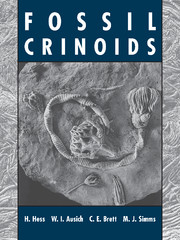Book contents
16 - Lower Mississippian Hampton Formation at LeGrand, Iowa, USA
Published online by Cambridge University Press: 10 November 2010
Summary
COLOURFUL CRINOIDS
Colonies and colours provide the fascination of LeGrand, Iowa, crinoids. The invertebrate palaeontology halls of most U.S. museums display a slab of buffcoloured dolomite covered with crinoid crowns. The slab may be up to 2 m across with small, perfectly preserved crowns and a tangle of stems forming an eyecatching display (Figs. 142, 143). Most of these museum display pieces are from the original large crinoid colony discovered during the preceding century. Crinoids occur in extensive, thin lenticular beds representing the original distribution of living crinoid colonies.
The buff-coloured dolomite provides an attractive background for these crinoids, but their aesthetic appeal nearly hides the most remarkable aspect of this fauna: the crinoids themselves are preferentially coloured. Preservation of this fauna was so good that certain species retain distinctive coloration. The earth tones that shade these fossils undoubtedly do not reflect living coloration, but the species-specific nature of this remarkable preservation does suggest some type of primary vital effect. However, in contrast to situation with other crinoids (see Chapter 4), the chemistry of the pigments responsible for the coloration has not yet been examined.
STRATIGRAPHY OF THE LEGRAND CRINOIDS
LeGrand crinoids are from the Maynes Creek Member of the Hampton Formation in north-central Iowa (Mississippian, approximately 355 million years old). The Maynes Creek is composed of approximately 20 m of fossiliferous buff- to brown-coloured dolomite interbedded with chert. These rocks were deposited in a fairly shallow-water epicontinental setting (Laudon 1931). The member immediately beneath the Maynes Creek Member is an oolitic unit. The Hampton Formation is Kinderhookian (Tournaisian 2) in age (Anderson 1969). Hampton crinoids occur in the centre of lenticular beds.
- Type
- Chapter
- Information
- Fossil Crinoids , pp. 135 - 138Publisher: Cambridge University PressPrint publication year: 1999
- 4
- Cited by



